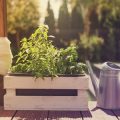1. Choosing the Right Location and Structure
Before you start building your vertical indoor garden with integrated grow lighting, its important to pick the best spot in your home and choose a structure that fits your space and style. A good location will help your plants thrive and make your setup both functional and attractive.
Finding the Ideal Spot Indoors
Your vertical garden will do best in an area with good air circulation and access to natural light. Even though youll be using grow lights, placing your garden near a window can provide extra support for plant health. Here are a few great options:
| Location | Benefits |
|---|---|
| Near South or West-Facing Windows | Extra sunlight, especially during winter months |
| Unused Walls in Living Rooms or Kitchens | Saves space while adding greenery to your home decor |
| Laundry Rooms or Bathrooms with Windows | Warmth and humidity that many indoor plants love |
| Hallways or Stairwells (with lighting) | Makes use of vertical space where floor space is limited |
Choosing a Vertical Garden Structure
Once you’ve picked a location, it’s time to decide on the type of structure for your garden. You want something sturdy enough to hold soil, water, and lighting components, but also compact enough to fit your chosen space.
Wall-Mounted Racks
These are great for small spaces and give a clean, modern look. They’re ideal if you want your plants to double as wall art. Just make sure the wall can support the weight of the setup once plants and lights are installed.
Freestanding Towers
If youre renting or don’t want to drill into walls, freestanding towers are a smart choice. They come in various sizes and are often designed with built-in shelves or slots for pots. Some even include spots for integrated grow lights.
Repurposed Shelves
An affordable option is to reuse bookshelves or storage racks. Add waterproof liners and install LED grow lights under each shelf layer. This DIY route gives you more control over customization and layout.
Quick Tips for Success
- Avoid spots near heating vents or air conditioners—too much hot or cold air can stress plants.
- Make sure theres easy access to an electrical outlet for your grow lights.
- If placing near a window, watch out for drafts or harsh direct sunlight through glass, which can burn some plants.
With the right location and structure chosen, you’re ready to start setting up your vertical indoor garden. In the next section, we’ll look at choosing plants that work well in vertical systems and indoor environments.
2. Selecting Plants Suited for Vertical Indoor Growing
Choosing the right plants is key to building a successful vertical indoor garden with integrated grow lighting. Since youre growing indoors and often in limited space, its important to pick plants that are compact, low-maintenance, and thrive under artificial light. Here’s how to make smart plant choices for your setup.
What Makes a Plant Ideal for Vertical Indoor Gardens?
When selecting plants, keep these characteristics in mind:
- Compact Size: Smaller plants fit better into vertical systems and don’t outgrow their space.
- Shallow Root Systems: Plants with shallow roots adapt well to wall-mounted or tiered containers.
- Low Maintenance: Choose varieties that don’t require frequent watering or pruning.
- Thrives Under Grow Lights: Opt for species that do well under LED or fluorescent grow lights.
Best Types of Plants for Indoor Vertical Gardens
The following categories include some of the best options for vertical indoor gardens using grow lights:
| Plant Type | Examples | Light Requirements | Care Level |
|---|---|---|---|
| Herbs | Basil, Mint, Thyme, Oregano | Moderate to High (12–16 hrs/day) | Easy |
| Leafy Greens | Lettuce, Spinach, Arugula, Kale | Moderate (10–14 hrs/day) | Easy |
| Dwarf Vegetables | Dwarf Peppers, Mini Tomatoes (like Micro Tom) | High (14–18 hrs/day) | Moderate |
| Small Flowering Plants | African Violets, Begonias | Moderate to High (12–16 hrs/day) | Moderate |
Tips for Choosing the Right Mix of Plants
- Group plants with similar light and water needs on the same level of your vertical garden.
- If youre new to indoor gardening, start with herbs and leafy greens—they’re forgiving and grow quickly.
- Add a pop of color with flowering plants once you’re comfortable managing basic care routines.
Pro Tip:
Select slow-growing or dwarf varieties whenever possible. These types stay manageable in size and reduce the need for constant pruning or transplanting.

3. Installing Integrated Grow Lighting
Lighting is one of the most important components of a successful vertical indoor garden. Without enough light, your plants wont thrive—even if you’ve chosen the right varieties and built a sturdy structure. In this section, we’ll walk you through how to select and install LED grow lights that provide the proper spectrum for plant growth and ensure even coverage throughout your vertical setup.
Choosing the Right LED Grow Lights
LED grow lights are ideal for indoor gardens because they’re energy-efficient, produce low heat, and offer customizable light spectrums. When selecting lights for your vertical garden, look for full-spectrum LEDs that mimic natural sunlight. These are best for supporting all stages of plant growth—from seedlings to mature plants.
Recommended Light Spectrum for Plant Growth
| Spectrum Type | Best For |
|---|---|
| Blue Light (400–500 nm) | Vegetative growth; helps leafy greens develop strong stems and leaves |
| Red Light (600–700 nm) | Flowering and fruiting; encourages blooms and yields in crops like tomatoes or strawberries |
| Full Spectrum (400–700 nm) | Covers all growth stages; ideal for mixed crops or year-round growing |
Planning Your Light Placement
The goal is to provide consistent lighting across each level of your vertical garden. Uneven lighting can lead to leggy plants or uneven growth. Consider these tips:
- Height: Mount your lights 12–24 inches above the plant canopy, depending on the intensity of the light.
- Coverage: Make sure each shelf receives equal light by choosing fixtures designed for wide-angle distribution or using multiple smaller units.
- Daisy-Chaining: Some LED grow lights allow daisy-chaining—connecting multiple lights together—which simplifies wiring and power management.
Installing Your Lights Safely
You can mount LED grow lights directly under each shelf using brackets, hooks, or suspension kits. Make sure all electrical components are secure and away from water sources. If possible, connect your lighting system to a timer so that your plants receive consistent light cycles—typically 14–16 hours per day for most edible greens and herbs.
A Quick Installation Checklist:
- Select full-spectrum LED grow lights suitable for your plant types
- Measure shelf dimensions to choose appropriate light sizes
- Use mounting hardware compatible with your shelving material
- Aim for uniform coverage across all tiers
- Add a timer to automate daily light cycles
- Safely route cords away from moisture and walking paths
A well-lit vertical garden doesnt just look great—it also gives your plants the energy they need to grow strong and healthy indoors. With the right setup, youll enjoy fresh herbs, greens, and more year-round.
4. Creating an Efficient Watering and Drainage System
When building a vertical indoor garden with integrated grow lighting, having the right watering and drainage setup is just as important as lighting and plant placement. Since youre growing indoors, preventing water spills and overwatering is key to keeping your space clean and your plants healthy.
Choosing the Right Watering Method
There are several ways to water your vertical garden efficiently. Depending on your plant choices, garden size, and available time, you can choose from these popular methods:
| Watering Method | Description | Best For |
|---|---|---|
| Drip Irrigation System | Uses small tubes and emitters to deliver water directly to each plants root zone. Can be automated with a timer. | Larger or multi-tiered gardens; people who travel often |
| Self-Watering Planters | Planters with built-in water reservoirs that allow plants to absorb moisture as needed through capillary action. | Small setups or individual pots; beginners |
| Manual Watering (Watering Can or Bottle) | You water the plants by hand using a watering can or squeeze bottle. Simple but requires attention. | Small-scale gardens; budget-conscious gardeners |
Setting Up Proper Drainage
Because youre working indoors, controlling excess water is critical. Heres how you can set up a drainage system that prevents messes and protects your home:
Use Trays or Catch Basins
Place shallow trays under each planter or shelf level to catch any extra water. Make sure they’re easy to remove and clean.
Add a Layer of Gravel or Pebbles
At the bottom of each container, add a layer of gravel or small stones before adding soil. This helps prevent roots from sitting in soggy soil.
Choose Containers with Drainage Holes
If possible, use pots with drainage holes. If you’re using decorative containers without holes, place a smaller pot inside that drains into the outer one.
Tips for Watering Success Indoors
- Check Soil Moisture: Stick your finger about an inch into the soil before watering. If it feels dry, its time to water.
- Avoid Overwatering: Too much moisture can lead to root rot and fungus issues. Less is often more indoors.
- Use Room-Temperature Water: Cold water can shock plant roots. Let tap water sit out for a few hours before using.
- Adjust Based on Lighting: Plants under stronger grow lights may need more frequent watering due to increased evaporation.
An efficient watering and drainage system makes maintaining your vertical indoor garden much easier while keeping your space tidy and leak-free. With just a bit of planning, you’ll create an environment where your plants thrive without the mess.
5. Maintaining Your Vertical Indoor Garden
Once your vertical indoor garden with integrated grow lighting is set up, keeping it healthy and thriving requires regular care. Understanding the basics of indoor plant maintenance will help your plants flourish and ensure you get the most out of your setup.
Trimming and Pruning
Regular trimming encourages new growth and helps prevent overcrowding in your vertical garden. Use clean, sharp scissors or pruning shears to remove dead leaves, yellowing foliage, or any overgrown branches. For herbs like basil or mint, pinching off the tops promotes bushier growth.
Fertilizing
Because indoor plants rely solely on the nutrients you provide, fertilizing is essential. Use a balanced, water-soluble fertilizer every 4–6 weeks, depending on the plant type. Be careful not to over-fertilize—too much can harm your plants.
| Plant Type | Fertilizer Frequency | Recommended Fertilizer Type |
|---|---|---|
| Leafy Greens (e.g., lettuce) | Every 4 weeks | Nitrogen-rich fertilizer |
| Herbs (e.g., basil, thyme) | Every 5-6 weeks | Balanced liquid fertilizer |
| Flowering Plants | Every 4-6 weeks | Bloom booster fertilizer (high in phosphorus) |
Pest Control
Pests like spider mites, aphids, or fungus gnats can still show up indoors. Inspect your plants weekly for signs of trouble such as sticky residue, spots on leaves, or webbing. If you spot pests early, try wiping the leaves with a damp cloth or spraying them with a mix of water and mild dish soap. For persistent problems, consider using an organic insecticidal soap.
Adjusting Light and Water Routines
Your integrated grow lights are a big help, but they need to be adjusted as plants grow. Raise the lights if taller plants start getting too close, or lower them if new seedlings need more intensity. Most grow lights should be on for about 12–16 hours per day—use a timer to make this easy.
Watering Tips by Plant Type:
| Plant Type | Watering Frequency | Notes |
|---|---|---|
| Cacti & Succulents | Every 2–3 weeks | Let soil dry completely between watering |
| Tropical Plants (e.g., pothos) | 1–2 times per week | Keep soil slightly moist but not soggy |
| Lettuce & Herbs | 2–3 times per week | Avoid letting soil dry out completely |
Troubleshooting Common Issues
If you notice slow growth or yellowing leaves, check your light exposure and watering habits first. Sometimes it’s just a matter of moving a plant closer to the light or letting the soil dry out before the next watering. Keeping a simple plant care journal can help track what works best for each variety in your garden.
A little attention goes a long way—just a few minutes a week can keep your vertical indoor garden lush and productive year-round.


